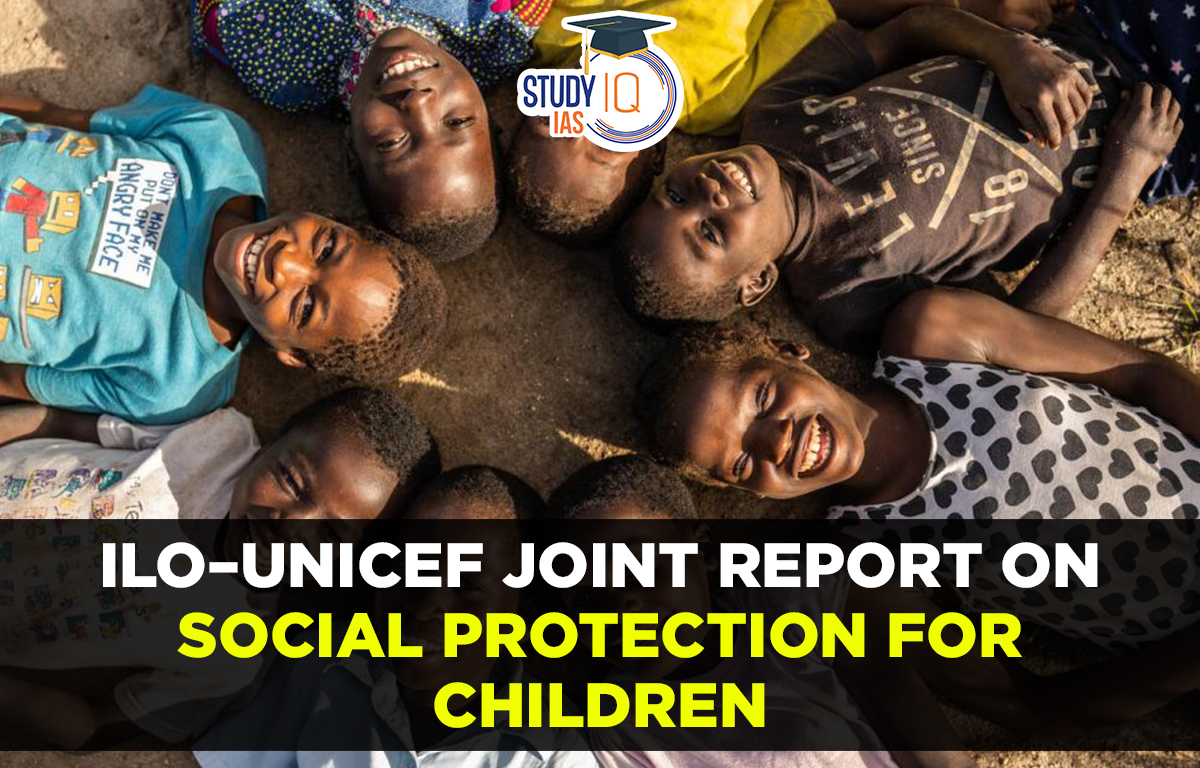Table of Contents
Context: The Second International Labour Organization–UNICEF joint report on social protection for children has been released.
Social Protection and its Need
- Social protection is a universal human right and a precondition for a world free from poverty.
- It is also a vital foundation to help the world’s most vulnerable children fulfill their potential and increase their access to food, nutrition, education, and healthcare.
- It provides resilience for households, allowing them to boost their productivity and earning potential, and lowers the risk of the intergenerational transmission of poverty.
- Investment in social protection for children expands human capabilities and productivity. It also fuels economic growth, contributing to more sustainable tax and transfer systems.
International Labour Organization(ILO)
- It was created in 1919, as part of the Treaty of Versailles that ended World War I.
- It is devoted to promoting social justice and internationally recognized human and labour rights.
- ILO is the only tripartite U.N. agency with government, employer, and worker representatives.
- India is a founder member of ILO.
- At present the ILO has 187 Members.
- It is headquartered in Geneva, Switzerland.
Key Highlights of the Report
- Access to Social Protection: Approximately 1.5 billion children below the age of 15 years currently have no access to social protection.
- In 2020, only 26.4% of children under 15 years globally received social protection cash benefits.
- Multidimensional Poverty: Over a billion children are living in multidimensional poverty i.e deprived of key dimensions of childhood such as health, education and nutrition.
- This results in heightening rights violations such as child labour and child marriage, and diminishing children’s aspirations and opportunities.
- Regional Disparities: Significant and troubling regional disparities exist in effective social protection coverage for children.
- In the Americas, coverage is 57.4%.
- Coverage remains relatively low in the Arab States at 15.4 %.
- In Asia and the Pacific, coverage is currently 18.0 %.
- Shock Responsiveness: With 73% of the world’s extreme poor and 24% of the global population currently living in fragile context, the need for shock-responsive social protection systems is urgent.
- This includes humanitarian assistance, humanitarian cash transfers, policy frameworks and operational mechanisms that allow the inclusion of populations impacted by crises.
- Gender Gap: Girls and women have been disproportionately impacted by multiple crises. They also experience higher poverty rates than boys and men and face multiple systematic barriers that impede gender equality.
- Disabled Children: Children with disabilities or living in a household with a family member with a disability are more vulnerable to poverty and face financial barriers to a full life, but are less likely to receive adequate social protection.
- Enhanced Challenges: Children constitute 41% of the 83.9 million forcibly displaced people across the world.
- Displaced children are at high risk of spending a quarter of their childhood in deprivation and facing uncertain futures.
Universal Child Benefits Schemes (UCBs): India
- National Scheme:
- PM CARES: The report states that 31 States have implemented the national “PM CARES for Children” scheme.
- This scheme supports children who have lost both parents or surviving parent or legal guardian or adoptive parents due to COVID-19 pandemic. It involves financial support till 23 years of age.
- PM CARES: The report states that 31 States have implemented the national “PM CARES for Children” scheme.
- State Schemes:
- Mukhya Mantri Kanya Utthan Yojana: It was launched in Bihar for young women aged 0–21 years and is fully funded by the state government, with the aim of combating systemic discrimination and gender inequality.
- Mukhya Mantri Sukanya Yojana: It was introduced in Jharkhand for girls and young unmarried women aged 0–20 years.
- Mukhya Mantri Kanya Sumangla Yojana: It was introduced in Uttar Pradesh for young unmarried women aged 0–18 years.
- They receive approximately 15,000 rupees split into seven installments over the life course.
Key Recommendations of the Report
- Accelerate progress towards universal coverage for children as a critical step towards improving their well-being.
- Guarantee adequate benefit levels to generate meaningful change in children’s lives.
- Provide a comprehensive range of benefits that supports children and families through a life-cycle approach.
- Ensure sustainable and equitable financing of social protection systems that allows for the necessary investment in social protection for children.
- Build social protection systems that are rights-based, inclusive, gender-responsive, informed by social dialogue and able to effectively respond to multiple shocks and crises.
- Ensure that social protection systems are adapted to developments in the world of work to enhance economic security for parents, caregivers and their families.


 Serious Fraud Investigation Office (SFIO...
Serious Fraud Investigation Office (SFIO...
 Article 142 of Indian Constitution, Sign...
Article 142 of Indian Constitution, Sign...
 Pakistan-Occupied Kashmir (PoK): History...
Pakistan-Occupied Kashmir (PoK): History...





















